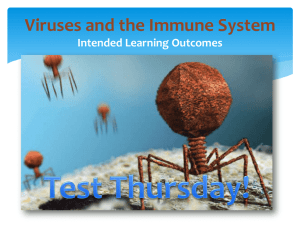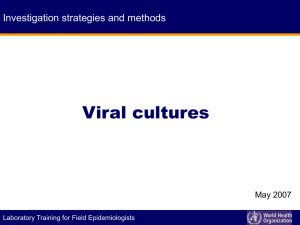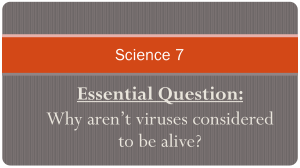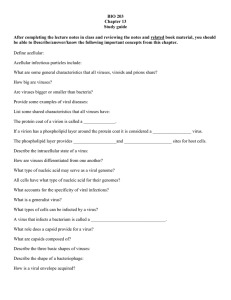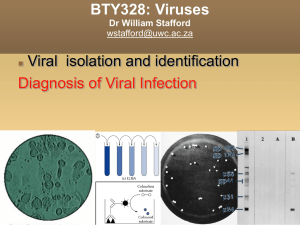b- Persistent viral infection
advertisement
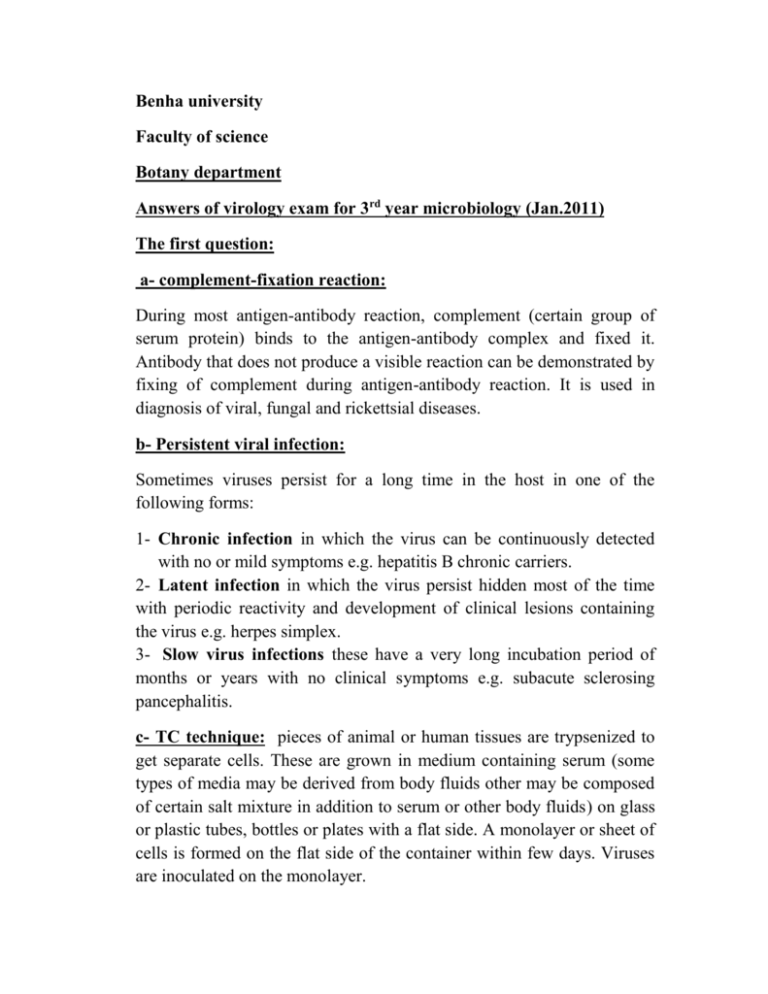
Benha university Faculty of science Botany department Answers of virology exam for 3rd year microbiology (Jan.2011) The first question: a- complement-fixation reaction: During most antigen-antibody reaction, complement (certain group of serum protein) binds to the antigen-antibody complex and fixed it. Antibody that does not produce a visible reaction can be demonstrated by fixing of complement during antigen-antibody reaction. It is used in diagnosis of viral, fungal and rickettsial diseases. b- Persistent viral infection: Sometimes viruses persist for a long time in the host in one of the following forms: 1- Chronic infection in which the virus can be continuously detected with no or mild symptoms e.g. hepatitis B chronic carriers. 2- Latent infection in which the virus persist hidden most of the time with periodic reactivity and development of clinical lesions containing the virus e.g. herpes simplex. 3- Slow virus infections these have a very long incubation period of months or years with no clinical symptoms e.g. subacute sclerosing pancephalitis. c- TC technique: pieces of animal or human tissues are trypsenized to get separate cells. These are grown in medium containing serum (some types of media may be derived from body fluids other may be composed of certain salt mixture in addition to serum or other body fluids) on glass or plastic tubes, bottles or plates with a flat side. A monolayer or sheet of cells is formed on the flat side of the container within few days. Viruses are inoculated on the monolayer. d- advantages and disadvantages of INFs as a theraputicagents: Advantages of interferon its high activity, its poor antigenicity, its broad antiviral spectrum and its lack of toxicity for host cells. disadvantages of interferon: 1- it is difficult to produce in large amounts 2- It is effective over relatively short periods. 3-It can not be used to block viral synthesis which has been initiated within the cell. The second question (identify): a- prions: prions contain protein only. They are small, proteinaceous particles and there is controversy as to whether they contain any nucleic acid, but if there is any there is very little and almost certainly not enough to code for protein. b- MIOS (Mycoplasma): 1- possess thin strong cytoplasmic membrane 2- cultivated on artificial media 3- give similar symptoms like viruses 4-their growth is inhibited by antiserum 5-their shape may be spiroplasma or spherical. c- eclipse phase: after penetration and uncoating phases most virus particles can not be detected for a period of some hours. During this phase several enzymes are produced by the host cells under control of the viral genome (the cellular metabolism is directed towards the synthesis of new virus particles. The eclipse phase ends with the formation of the infectious virus. d-cytopathic viruses : these viruses lead to: 1- cell death, rounding of cell and destruction of monolayer (polioviruses) 2- ballooning of cells (herpes simplex) 3- clumps of rounded cells like bunches of grapes (adenoviruses) 4- multinucleate giant cell (measles). The third question: The mode of transmission of plant viruses: Plant viruses can be transmitted without vectors (by contact, through seed, pollen and organs of vegetative propagation) or by vectors (human and animals, insects as Myzus persicae, and aphids, spider mites, nematodes and fungi). The mode of transmission of animal viruses: a- Directly by 1-inhalation, e.g. influenza 2- ingestion, e.g. hepatitis A 3-contact, e.g. infectious mononucleosis b-Indirectly by 1-Arthropods, e.g. yellow fever 2- injection,e.g. hepatitis B c- Bite of animal, e.g. rabies.// تاريخ اإلمتحان الثالثاء 2011/1/18 صباح أبو المعاطي أحمد. د:أستاذ المادة مدرس بقسم النبات






